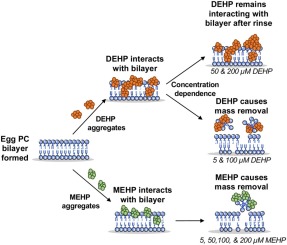当前位置:
X-MOL 学术
›
Colloids Surf. B Biointerfaces
›
论文详情
Our official English website, www.x-mol.net, welcomes your
feedback! (Note: you will need to create a separate account there.)
Investigating interactions of phthalate environmental toxicants with lipid structures.
Colloids and Surfaces B: Biointerfaces ( IF 5.4 ) Pub Date : 2020-03-02 , DOI: 10.1016/j.colsurfb.2020.110923 Christina M Bailey-Hytholt 1 , Tanaya Puranik 1 , Anubhav Tripathi 1 , Anita Shukla 1
Colloids and Surfaces B: Biointerfaces ( IF 5.4 ) Pub Date : 2020-03-02 , DOI: 10.1016/j.colsurfb.2020.110923 Christina M Bailey-Hytholt 1 , Tanaya Puranik 1 , Anubhav Tripathi 1 , Anita Shukla 1
Affiliation

|
Di(2-ethylhexyl) phthalate (DEHP) is one of the most abundant plasticizers in common household products. It leaches from materials, resulting in exposure associated with detrimental health effects. The main objective of this study was to investigate how DEHP and its metabolite, mono(2-ethylhexyl) phthalate (MEHP), interact with and permeate lipid structures, namely vesicles and planar bilayers. Using dynamic light scattering, we observed significant changes in the size and polydispersity of L-α-phosphatidylcholine (egg PC) vesicles when incubated with DEHP but not MEHP at the same concentrations (100 and 200 μM). We demonstrated that these effects are mitigated by pre-treatment with chitosan nanoparticles which adsorb the phthalates. Using quartz crystal microbalance with dissipation monitoring (QCM-D), we observed a concentration dependence on the interaction of DEHP with egg PC supported lipid bilayers (SLBs). QCM-D results suggested lipid removal for 5 and 100 μM DEHP, and adsorption and potential embedment in the bilayer at 50 and 200 μM DEHP. SLB mass decrease was observed for all concentrations of MEHP (5, 50, 100, and 200 μM), suggesting lipid removal. We also investigated the permeability of DEHP and MEHP as well as several small molecules across a 1,2-dioleoyl-sn-glycero-3-phosphocholine (DOPC) suspended lipid bilayer. We found that DEHP and MEHP both had low permeabilities, but only DEHP remained associated with the bilayer. Exposure to DEHP and MEHP influenced how several common small molecules interacted with DOPC bilayers. Ultimately, this work provides insight into mechanisms of phthalate interactions with lipid structures, having implications for human health.
中文翻译:

研究邻苯二甲酸酯类环境毒物与脂质结构的相互作用。
邻苯二甲酸二(2-乙基己基)酯(DEHP)是普通家用产品中含量最丰富的增塑剂之一。它从材料中浸出,导致暴露于有害健康的影响。这项研究的主要目的是研究DEHP及其代谢产物邻苯二甲酸单(2-乙基己基)酯(MEHP)如何与脂质结构(即囊泡和平面双层)相互作用并渗透。使用动态光散射,我们观察到当与DEHP孵育而不是在相同浓度(100和200μM)的MEHP孵育时,L-α-磷脂酰胆碱(egg PC)囊泡的大小和多分散性发生了显着变化。我们证明了通过用吸附邻苯二甲酸酯的壳聚糖纳米颗粒进行预处理可以减轻这些影响。使用石英微天平和耗散监测(QCM-D),我们观察到浓度依赖于DEHP与蛋PC支持的脂质双层(SLB)的相互作用。QCM-D结果表明,对于5和100μM的DEHP,应去除脂质,并在50和200μM的DEHP下,吸附和潜在嵌入双层中。对于所有浓度的MEHP(5、50、100和200μM),SLB质量均降低,表明脂质去除。我们还研究了DEHP和MEHP以及几个小分子跨过1,2-二油酰基-sn-甘油-3-磷酸胆碱(DOPC)悬浮脂质双层的渗透性。我们发现DEHP和MEHP的渗透率均较低,但只有DEHP与双层结合。暴露于DEHP和MEHP会影响几种常见的小分子与DOPC双层的相互作用。最终,这项工作使人们深入了解了邻苯二甲酸酯与脂质结构的相互作用机理,
更新日期:2020-03-02
中文翻译:

研究邻苯二甲酸酯类环境毒物与脂质结构的相互作用。
邻苯二甲酸二(2-乙基己基)酯(DEHP)是普通家用产品中含量最丰富的增塑剂之一。它从材料中浸出,导致暴露于有害健康的影响。这项研究的主要目的是研究DEHP及其代谢产物邻苯二甲酸单(2-乙基己基)酯(MEHP)如何与脂质结构(即囊泡和平面双层)相互作用并渗透。使用动态光散射,我们观察到当与DEHP孵育而不是在相同浓度(100和200μM)的MEHP孵育时,L-α-磷脂酰胆碱(egg PC)囊泡的大小和多分散性发生了显着变化。我们证明了通过用吸附邻苯二甲酸酯的壳聚糖纳米颗粒进行预处理可以减轻这些影响。使用石英微天平和耗散监测(QCM-D),我们观察到浓度依赖于DEHP与蛋PC支持的脂质双层(SLB)的相互作用。QCM-D结果表明,对于5和100μM的DEHP,应去除脂质,并在50和200μM的DEHP下,吸附和潜在嵌入双层中。对于所有浓度的MEHP(5、50、100和200μM),SLB质量均降低,表明脂质去除。我们还研究了DEHP和MEHP以及几个小分子跨过1,2-二油酰基-sn-甘油-3-磷酸胆碱(DOPC)悬浮脂质双层的渗透性。我们发现DEHP和MEHP的渗透率均较低,但只有DEHP与双层结合。暴露于DEHP和MEHP会影响几种常见的小分子与DOPC双层的相互作用。最终,这项工作使人们深入了解了邻苯二甲酸酯与脂质结构的相互作用机理,









































 京公网安备 11010802027423号
京公网安备 11010802027423号